START |
| |
Teddington Lock |
|
|
| |
|
The Teddington Launch lock (the centre one of three current locks) was first built the Corporation of the City of London in 1811 but it had to be extensively repaired in 1825. It was rebuilt by the Thames Conservancy in 1858 when they also constructed the Skiff Lock. The Barge Lock was built in 1904, also by the Thames Conservancy. Flood lighting and electric signals to control river traffic was installed in 1953. All three locks remain in operation today. The locks at Teddington are manned 24 hours a day. |
|
| |
Richmond Bridge |
|
|
| |
|
Richmond bridge is made from Portland stone and was freed from tolls in 1859 and widened in 1937. Before Richmond Bridge opened in 1777, a ferry owned by the Crown operated at this point on the river. |
|
| |
Richmond Railway Bridge |
|
|
| |
|
After the railway came to Richmond station in 1846, the line was extended to Windsor . Joseph Locke designed the original bridge with three 100-foot cast iron girders supported on stone-faced land arches with two stone-faced river piers . Due to concerns over its structural integrity, the bridge was rebuilt in 1908 reusing the existing piers and abutments to a design by the London & South Western Railway's chief engineer, J W Jacomb-Hood. The bridge was declared a Grade II listed structure in 2008, providing protection to preserve its special character from unsympathetic development. |
|
| |
Twickenham Bridge |
|
|
| |
|
This bridge was built to relieve increasing congestion on Richmond Bridge and take the Chertsey arterial road across the Thames.
Despite plans for the bridge being suggested in 1909, as a result of the 1914-18 War and disagreements on the exact route and financing of the bridge, it was not until 1926 that the Ministry of Transport decided to go ahead, appointing Maxwell Ayrton as architect and Alfred Dryland as head engineer for the project. However, the extensive construction operation meant that over 300 families had to be relocated as houses and shops were demolished to accommodate the new route. |
|
| |
Richmond Footbridge |
|
|
| |
|
Richmond Lock and Weir, also known as Richmond Footbridge. 5 miles from Putney by road. Two hours after high tide the sluice gates are lowered to block the river. This keeps the water level navigable up to Teddington Lock 3.25 miles away. Two hours before high tide they are raised again to let the tide flow normally. While the river is blocked boats can pass through the lock on the Surrey side of the bridge. |
|
| |
Kew Bridge |
|
|
| |
|
The first bridge was constructed with two stone arches at each end and 7 timber arches in between, which proved costly to maintain and as a consequence the bridge only lasted 30 years. In 1782 Robert Tunstall, son of the builder of the first bridge, obtained consent to replace the bridge and work began on 4 June 1783 , the anniversary date of the first bridge opening to the public. The new bridge was designed by James Paine who had previously been responsible for Richmond Bridge . The cost was £16,500 which was raised by means of a tontine . |
|
| |
|
|
|
| |
|
This bridge was opened in 1869. It consists of five wrought Iron lattice girder spans of 35 metres each. The cast iron piers are decorated in three stages and can be seen from inside a passing train. The bridge carries 2 tracks which are electrified with both third rail and London Underground style fourth rail . It runs between Kew and Strand on the Green, Chiswick. Just upstream of the railway bridge is Oliver Island.
The bridge was given Grade II listed structure protection in 1983.
|
|
| |
Chiswick Bridge |
|
|
| |
|
Chiswick Bridge is a reinforced concrete deck arch bridge. One of three bridges opened in 1933 as part of an ambitious scheme to relieve traffic congestion west of London, it carries the A316 road between Chiswick on the north bank of the Thames and Mortlake on the south bank. Built on the site of a former ferry , the bridge is 606 feet (185 m) long and faced with 3,400 tons of Portland stone . At the time of its opening its 150-foot (46 m) central span was the longest concrete span over the Thames. The bridge is possibly best known today for its proximity to the end of The Championship Course , the stretch of the Thames used for the Boat Race and other rowing races. |
|
| |
Barnes Railway Bridge |
|
|
| |
|
The original bridge at this location was built in 1849 to a design by Joseph Locke and looked very similar to the original Richmond Railway Bridge which he also designed. The replacement bridge, designed by Edward Andrews, is three spans of wrought iron bow string girders carrying two railway tracks. The construction work was carried out by Head Wrightson on behalf of the London & South Western Railway and was completed in 1895. The original Locke span still stands unused on the upstream side. The bridge was given protection as a Grade II listed structure in 1983. |
|
| |
Hammersmith Bridge |
|
|
| |
|
The construction of a bridge was first sanctioned by an Act of Parliament in 1824 and work on site began the following year. It was the Thames' first suspension bridge and was designed by William Tierney Clark . The bridge had a clear water-way of 688 feet 8 inches (209.9 m). Its suspension towers were 48 feet (15 m) above the level of the roadway, where they were 22 feet (6.7 m) thick. In 1884 a temporary bridge was put up to allow limited cross-river traffic while this replacement was constructed. The current suspension bridge was designed by noted civil engineer Sir Joseph Bazalgette and rests on the same pier foundations as the original. |
|
| |
Putney Bridge |
|
|
| |
|
Construction of a bridge was first sanctioned by an Act of Parliament in 1726 . Built by local master carpenter Thomas Phillips to a design by architect Sir Jacob Ackworth , the first bridge was opened in November 1729 , to become the only bridge between London Bridge and Kingston Bridge at the time. A toll bridge , it featured tollbooths at either end of the timber-built structure. The bridge was badly damaged by the collision of a river barge in 1870, and although part of the bridge was subsequently replaced, soon the entire bridge would be demolished and in 1886 it was replaced by the stone bridge that stands today. |
|
| |
Fulham Railway Bridge |
|
|
| |
|
Fulham Railway Bridge crosses the River Thames in London . It is very close to Putney Bridge , and carries the London Underground District Line between Putney Bridge station on the North, and East Putney station on the South. Fulham Railway Bridge can also be crossed on foot, on the downstream (east) side. The bridge is of lattice girder construction and 418 metres long, with 5 spans totalling 301 metres actually across the river, two further spans on the southern shore, and one on the north. It was designed by Brunel 's former assistant William Jacomb, built by Head Wrightson and opened in 1889. |
|
| |
Wandsworth Bridge |
|
|
| |
|
The first bridge was a toll bridge built by Julian Tolmé in 1873, in the expectation that the terminus of the Hammersmith and City Railway would shortly be built on the north bank. The railway terminus was not built. Wandsworth Bridge was not commercially successful, and in 1880 was taken into public ownership and made toll-free. As the bridge was narrow and unable to carry buses, it was decided to replace it. In 1937 it was demolished, and the present bridge, an unadorned steel cantilever bridge designed by Sir Pierson Frank , was opened in 1940. At the time of its opening it was painted in dull shades of blue and grey as camouflage against air raids , a colour scheme it still retains. |
|
| |
Battersea Railway Bridge |
|
|
| |
|
The Battersea Railway Bridge - properly called the Cremorne Bridge , after the pleasure grounds in Chelsea and originally commonly referred to as the Battersea New Bridge. The bridge was designed by William Baker , chief engineer of the London and North Western Railway , and was opened in March 1863 at a cost of £87,000. The bridge was declared a Grade II listed structure in 2008, providing protection to preserve its special character from unsympathetic development. |
|
| |
Battersea Bridge |
|
|
| |
|
It was an Act of Parliament in 1766 that authorised Earl Spencer to build a river crossing between Battersea and Chelsea on the River Thames. The Earl, who operated a ferry service at the time, did not have sufficient money to build a stone bridge so the original structure was made of timber. In 1886 Sir Joseph Bazalgette the legendary designer of the London sewer system built a new five span steel and iron cantilever bridge which still stands today. |
|
| |
Albert Bridge |
|
|
| |
|
Although Chelsea and Battersea were then linked by two bridges, the wooden Battersea Bridge had become dilapidated by the mid-19th century. It had grown unpopular and was considered unsafe. The newer Victoria Bridge, meanwhile, suffered severe congestion. In 1860, Prince Albert suggested that a new tollbridge built between the two existing bridges would be profitable, and in the early 1860s the Albert Bridge Company was formed with the aim of building this new crossing. An 1863 proposal was blocked by strong opposition from the operators of Battersea Bridge, which was less than 500 yards (460 m) from the proposed site of the new bridge and whose owners were consequently concerned over potential loss of custom. |
|
| |
Chelsea Bridge |
|
|
| |
|
The first Chelsea Bridge was proposed in the 1840s as part of a major development of marshlands on the south bank of the Thames into the new Battersea Park . It was a suspension bridge.
Although built and operated by the government, tolls were charged initially in an effort to recoup the cost of the bridge. Work on the nearby Chelsea Embankment delayed construction and so the bridge, initially called Victoria Bridge, did not open until 1857. Although well received architecturally, as a toll-bridge it was unpopular with the public, and Parliament felt obliged to make it toll-free on Sundays.
It was acquired by the Metropolitan Board of Works in 1877, and the tolls were abolished in 1879.
Between 1934 and 1937 it was demolished and replaced by the current structure which opened in 1937. |
|
| |
Victoria Railway Bridge (Grosvenor Bridge) |
|
|
| |
|
Grosvenor Bridge , often alternatively called Victoria Railway Bridge , is a railway bridge between Vauxhall Bridge and Chelsea Bridge . It actually consists of two bridges, both built in the mid-19th century. The eastern side was built by the London, Chatham and Dover Railway in 1858 to 60 to carry trains into Victoria station ; it was the first railway bridge across the Thames in central London. The western side was built by the London, Brighton and South Coast Railway in 1865 to 66. The designers were Sir John Fowler and Sir Charles Fox for the two bridges respectively. Both bridges were rebuilt in steel in 196367, the original piers now being encased in concrete.
|
|
| |
Battersea Power Station |
|
|
| |
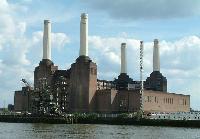 |
Battersea Power Station is a now unused coal-fired power station located on the south bank of the River Thames , near Battersea in London . The station comprises two individual power stations, built in two stages in the form of a single building. Battersea A Power Station was built first in the 1930s, with Battersea B Power Station to its east in the 1950s. The two stations were built to an identical design, providing the well known four chimney layout. The station ceased generating electricity in 1983, but over the past 50 years it has become one of the best known landmarks in London and is Grade II* listed.
The station's celebrity owes to numerous cultural appearances, which include a shot in The Beatles' 1965 movie Help! and being used in the cover art of Pink Floyd 's 1977 album Animals . |
|
| |
Vauxhall Bridge |
|
|
| |
|
Vauxhall Bridge is a Grade II* listed steel and granite deck arch bridge.
Opened in 1906, it replaced an earlier bridge, originally known as Regent Bridge but later renamed Vauxhall Bridge, built between 18091816 as part of a scheme for redeveloping the south bank of the Thames. The original bridge was itself built on the site of a former ferry.
In 1963 it was proposed to replace the bridge with a modern development containing seven floors of shops, office space, hotel rooms and leisure facilities supported above the river, but the plans were abandoned due to costs. With the exception of alterations to the road layout and the balustrade , the design and appearance of the current bridge has remained almost unchanged since 1907. |
|
| |
Lambeth Bridge |
|
|
| |
|
The most conspicuous colour in the bridge's current paint scheme is red, the same colour as the leather benches in the House of Lords which is at the southern end of the Palace of Westminster nearest the bridge. This is in contrast to Westminster Bridge which is predominantly green, the same colour as the benches in the House of Commons at the northern end of the Houses of Parliament.
On the east side, in Lambeth are Lambeth Palace , the Albert Embankment , St. Thomas' Hospital , and the International Maritime Organization . On the west side, in Westminster , are Thames House (the headquarters of MI5 )
|
|
| |
The Houses of Parliament and Big Ben |
|
|
| |
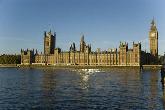 |
"Big Ben" does not refer to the whole clocktower, but to the huge thirteen ton bell that strikes the hour. Also known as The Palace of Westminster, The Houses of Parliament incorporates The House of Commons (destroyed in WW2, rebuilt 1950), The House of Lords & Westminster Hall. You can visit the Houses of Parliament to watch proceedings from the public gallery. Beware, MPs have absurdly long holidays or "recesses".
During the Summer Recess the Palace of Westminster, home to the House of Lords and the House of Commons is open for a one hour guided tour, which includes both Chambers and other great State Rooms.
|
|
| |
Westminster Bridge |
|
|
| |
|
For over 600 years, the nearest bridge to London Bridge was at Kingston. Proposals for a bridge at Westminster had been made as early as 1664. These were opposed by the Corporation of London and the watermen. Despite further opposition in 1722 and after a new timber bridge was built at Putney in 1729, the scheme received parliamentary approval in 1736. Financed by private capital, lotteries and grants, Westminster Bridge, designed by the Swiss architect Charles Labelye , was built between 1739-1750. It was only the second bridge crossing to be built across the Thames below Kingston when opened.
The City of London responded to Westminster Bridge by removing the buildings on London Bridge and widening it in 1760-63.
|
|
| |
London Eye |
|
|
| |
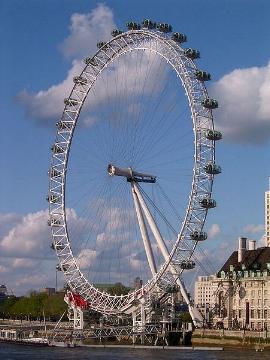 |
The Merlin Entertainments London Eye (known more simply as The London Eye , and also known as the Millennium Wheel ), at a height of 135 metres (443 ft), is the largest Ferris wheel in Europe , and has become the most popular paid tourist attraction in the United Kingdom , visited by over three million people in one year. At the time it was erected, in 1999, it was the tallest Ferris wheel in the world, until it was surpassed by the Star of Nanchang (160 m) in May 2006, and then the Singapore Flyer (165 m) on 11 February 2008. However, it is still described by its operators as "the world's tallest cantilevered observation wheel" (as the entire structure is supported by an A-frame on one side only).
The wheel carries 32 sealed and air-conditioned egg-shaped passenger capsules, attached to its external circumference, each capsule representing one of the London Boroughs . Each 10 tonne capsule holds 25 people, who are free to walk around inside the capsule, though seating is provided. It rotates at 26 cm (10 in) per second (about 0.9 km/h (0.6 mph) so that one revolution takes about 30 minutes. The wheel does not usually stop to take on passengers: the rotation rate is so slow that they can walk on and off the moving capsules at ground level. It is, however, stopped to allow disabled or elderly passengers time to embark and disembark safely |
|
| |
Charing Cross Railway Bridge (Hungerford Bridge) |
|
|
| |
|
In 1859 the original bridge was bought by the railway company extending the South Eastern Railway into the newly opened Charing Cross railway station . The railway company replaced the suspension bridge with a structure designed by Sir John Hawkshaw , comprising nine spans made of wrought iron lattice girders, which opened in 1864. The chains from the old bridge were re-used in Bristol 's Clifton Suspension Bridge . The original brick pile buttresses of Brunel's footbridge are still in use, though the one on the Charing Cross side is now much closer to the river bank than it was originally, due to the building of the Victoria Embankment , completed in 1870. |
|
| |
Waterloo Bridge |
|
|
| |
|
The first bridge on the site was designed in 1809-10 by John Rennie for the Strand Bridge Company and opened in 1817 as a toll bridge.
By the 1920s the problems had increased, with settlement at pier five necessitating closure of the whole bridge while some heavy superstructure was removed and temporary reinforcements put in place. London County Council decided to demolish the bridge and replace it with a new structure designed by Sir Giles Gilbert Scott . Scott, however, by his own admission was no engineer and his design, with reinforced concrete beams under the footways, leaving the road to be supported by transverse slabs, was difficult to implement. |
|
| |
Blackfriars Bridge |
|
|
| |
|
Although the original bridge was built of Portland stone the workmanship was very faulty. Between 1833 and 1840 extensive repairs were necessary, and a good deal of patching-up was done, until at last it was decided to build a new bridge on the same site (the present bridge), which, in 1869, was opened by Queen Victoria. The present bridge is 923 feet long, consisting of five wrought iron arches built to a design by Thomas Cubitt . Cubitt also designed the adjacent rail bridge (now demolished) and it was a condition that the spans of the two bridges be aligned. It was built by P.A. Thom & Co. and is owned and maintained by the City Bridge Trust , a charitable trust overseen by the City of London Corporation . Due to the volume of traffic over the bridge, it was widened between 190710, from 70 feet (21 m) to its present 105 feet (32 m).
|
|
| |
Blackfriars Railway Bridge |
|
|
| |
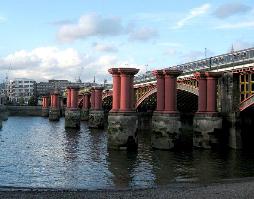 |
There have been two structures with the name. The first bridge was opened in 1864 and was designed by Joseph Cubitt for the London, Chatham and Dover Railway . Massive abutments at each end carried the railway's insignia, preserved and restored on the south side. The use of the original bridge gradually declined. It eventually became too weak to support modern trains, and was therefore removed in 1985 - all that remains is a series of columns crossing the Thames. The second bridge, built slightly further downstream (to the east), was originally called St Paul's Railway Bridge and opened in 1886. It was designed by John Wolfe-Barry and Henri Marc Brunel and is made of wrought iron. It was built by Lucas & Aird . When St Paul's railway station changed its name to Blackfriars in 1937 the bridge changed its name as well. |
|
| |
Millennium Bridge |
|
|
| |
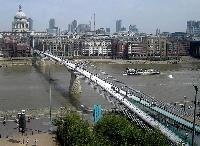 |
The design of the bridge was by Arup , Foster and Partners and Sir Anthony Caro . The bridge has two river piers and is made of three main sections of 81 metres (266 ft), 144 metres (472 ft) and 108 metres (354 ft) (North to South) with a total structure length of 325 metres (1,066 ft); the aluminium deck is 4 metres (13 ft) wide. The eight suspension cables are tensioned to pull with a force of 2,000 tons against the piers set into each bank enough to support a working load of 5,000 people on the bridge at one time.
Londoners nicknamed the bridge the Wobbly Bridge after crowds of pedestrians felt an unexpected swaying motion on the first two days after the bridge opened. The bridge was closed, and modifications eliminated the wobble entirely. It was reopened in 2002. |
|
| |
Southwark Bridge |
|
|
| |
 |
A previous bridge on the site, designed by John Rennie , opened in 1819, consisted of three large cast-iron spans supported by granite piers. It was known as the "Iron Bridge" in comparison to London Bridge the "Stone Bridge". The bridge was notable for having the longest cast iron span, 240 feet (73 m), ever made. It is frequently referenced by Charles Dickens , for example in Little Dorrit and Our Mutual Friend , and there was a recreation of the old bridge made for the 2008 Little Dorrit (TV serial) .
The current bridge was given Grade II listed structure status in 1995. |
|
| |
Cannon Street Railway Bridge |
|
|
| |
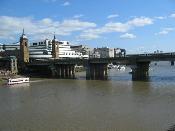 |
Cannon Street Railway Bridge was designed by John Hawkshaw and John Wolfe-Barry for the South Eastern Railway . It was opened in 1866 after three years of construction. In its original form, it carried the railway over the Thames on five spans standing on cast-iron Doric pillars. It was subsequently widened between 188693 by Francis Brady and extensively renovated between 197982, which resulted in many of its ornamental features being removed and the structure taking on an even more utilitarian appearance than before. |
|
| |
|
|
|
| |
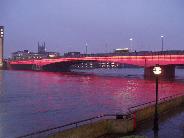 |
It was the only bridge over the Thames downstream from Kingston until Putney Bridge opened in 1729. The current bridge opened on 17 March 1973 and is the latest in a succession of bridges to occupy the spot and claim the name.
A bridge has existed at or near the present site over the period from the Roman occupation of the area, nearly 2,000 years ago. The first bridge across the Thames in the London area, probably a military pontoon bridge , was built of wood by the Romans on the present site around 50 AD.
By 1924, the east side of London Bridge was some three to four inches (102 mm) lower than the west side; it soon became apparent that this bridge would have to be removed and replaced with a more modern one. The old bridge was sold, then taken apart in 1968
and reconstructed at Lake Havasu City, Arizona |
|
| |
HMS Belfast |
|
|
| |
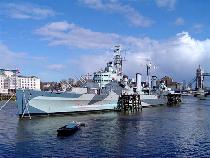 |
HMS Belfast is one of the two ships forming the final sub-class of the Royal Navy's Town-class cruisers , the other being HMS Edinburgh . Commissioned shortly before the outbreak of the Second World War , Belfast spent much of the early war years undergoing extensive repairs after being heavily damaged by a German mine . Returning to action in late 1942, she saw action escorting Arctic convoys to the Soviet Union during 1943 and participated in the Battle of North Cape . In 1944 Belfast supported the D-Day landings of Operation Overlord . She saw further action during the Korean War . Decommissioned in 1963 following a number of overseas tours Belfast was initially expected to be disposed of as scrap. After a campaign by a private trust, she was preserved as a museum ship in the Pool of London .
|
|
| |
Tower of London |
|
|
| |
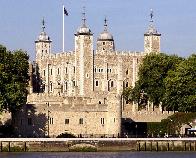 |
Her Majesty's Royal Palace and Fortress , more commonly known as the Tower of London (and historically as The Tower ), is a historic fortress and scheduled monument.
The Tower of London is often identified with the White Tower , the original stark square fortress built by William the Conqueror in 1078. However, the Tower as a whole is a complex of several buildings set within two concentric rings of defensive walls and a moat .
It has served as a place of execution and torture , an armoury , a treasury , a zoo , the Royal Mint , a public records office, an observatory , and since 1303, the home of the Crown Jewels of the United Kingdom . |
|
| |
Tower Bridge |
|
|
| |
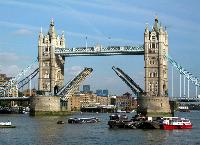 |
Tower Bridge is a combined bascule and suspension bridge in London , over the River Thames . It is close to the Tower of London , which gives it its name. It has become an iconic symbol of London.
The bridge consists of two towers which are tied together at the upper level by means of two horizontal walkways which are designed to withstand the horizontal forces exerted by the suspended sections of the bridge on the land-ward sides of the towers. The vertical component of the forces in the suspended sections and the vertical reactions of the two walkways are carried by the two robust towers. The bascule pivots and operating machinery are housed in the base of each tower. |
|
| |
The Cutty Sark |
|
|
| |
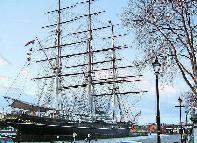 |
The Cutty Sark is a clipper ship. Built in 1869, she served as a merchant vessel (the last clipper to be built for that purpose), and then as a training ship until being put on public display in 1954. She is preserved in dry dock in Greenwich , London . However, the ship was badly damaged in a fire on 21 May 2007 while undergoing extensive restoration. The ship will be reopened in Summer 2010.
The Cutty Sark is the only remaining original clipper ship from the nineteenth century. |
|
| |
The Royal Greenwich Observatory |
|
|
| |
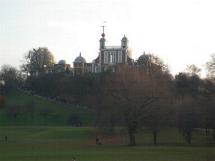 |
The Royal Observatory, Greenwich (formerly the Royal Greenwich Observatory or RGO ) was commissioned in 1675 by King Charles II , with the foundation stone being laid on 10 August . At this time the king also created the position of Astronomer Royal (initially filled by John Flamsteed ). There had been significant buildings on this land since the reign of Edward I. Greenwich Palace , next to the site of the present-day Observatory was the birthplace of Henry VIII and the Tudors used Greenwich Castle , which was built on the land that the Observatory now stands on. Greenwich Castle was apparently a favourite place for Henry VIII to house his mistresses, so that he could easily travel from the Palace to see them. Thr Greenwich meridian passes through this site. |
|
| |
Seahorses at Greenwich |
|
|
| |
|
Following the discovery of the short-snouted seahorses at Southend in May 2010, they were found as far upstream as Greenwich in September 2011. How far upstream can they go? |
|
| |
The Millennium Dome (O2) |
|
|
| |
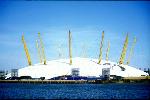 |
The Millennium Dome , often referred to simply as The Dome , is the original name of a large dome -shaped building, originally used to house the Millennium Experience , a major exhibition celebrating the beginning of the third millennium . Located on the Greenwich Peninsula in South East London , the exhibition opened to the public on 1 January 2000 and ran until 31 December 2000. The project and exhibition was the subject of considerable political controversy as it failed to attract the number of visitors anticipated, leading to recurring financial problems. While all of the original exhibition and associated complex has since been demolished, the canopy or shell of the dome still exists, and it is now a key exterior feature of the The O 2 entertainment district. |
|
| |
Air Line Cable Car |
|
|
| |
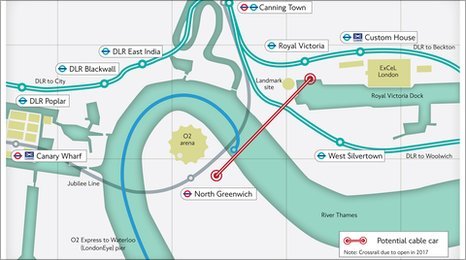 |
A planned cable car above the River Thames in London has been given the final clearance by the Greater London Authority (GLA). The crossing will link two 2012 Olympic venues, the O2 arena in Greenwich with the ExCel exhibition centre in the Royal Docks in east London. Airline Emirates has signed up to a £36 million sponsorship deal which will see the Wilkinson Eyre-designed Thames cable car branded with its logo and name. The £50.5 million project has already started on site and is due to complete in time for the opening of the London 2012 Olympic Games
|
|
| |
Thames Barrier |
|
|
| |
 |
Thames Barrier is a large flood control structure on the River Thames , constructed between 1974 and 1982 at Woolwich Reach, and first used defensively in 1983. It is the world's second largest movable flood barrier (the largest is the Maeslantkering in The Netherlands ).
Located downstream of central London, the barrier's purpose is to prevent London from being flooded by an exceptionally high tide moving up from the sea, often exacerbated by a storm surge . It only needs to be raised for the duration of the high tide; at ebb tide it can be lowered to release upstream water that backs up behind it. |
|
| |
Woolwich Ferry |
|
|
| |
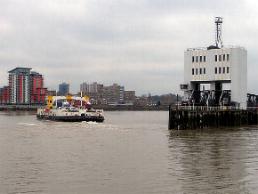 |
The Woolwich Free Ferry is a boat service across the River Thames , London , UK , which is licensed and financed by London River Services , the maritime arm of Transport for London. The service is operated by Serco Group under licence from TfL and carries both foot passengers and vehicles.
The service links Woolwich in the London Borough of Greenwich with North Woolwich in the London Borough of Newham . It also links two ends of the inner London orbital road routes: the North Circular and the South Circular . |
|
| |
Queen Elizabeth II Bridge |
|
|
| |
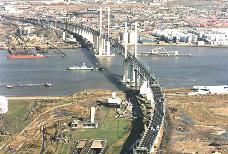 |
The Queen Elizabeth II Bridge , a 137 metre high cable-stayed bridge . Before the opening of the road bridge, the crossing was known as the Dartford Tunnel . The crossing forms part of London's orbital M25 motorway (although officially not part of the M25 and carries nearly 150,000 vehicles a day.The QEII Bridge was built alongside the tunnels, to the east, and was opened in 1991. Southbound traffic crosses via the four lane bridge, while northbound traffic travels in both of the two lane road tunnels. In bad weather or high winds, the bridge is closed and the crossing reverts to use of the two tunnels for both directions as was the case before the bridge was built. |
|
| |
Southend Pier |
|
|
| |
|
In the early 19th century, Southend was growing as a resort . At the time, it was thought that spending time at the seaside was good for one's health, and since it was close to the capital, many Londoners would come to Southend for this reason. However the coast at Southend consists of large mudflats , so the sea is never very deep even at full tide, and recedes for well over a mile at low tide. Because of this large boats were unable to stop at Southend. This meant that many potential visitors would travel past Southend and go to other resorts where docking facilities were better. Local dignitaries pushed for a pier to be built to allow boats to reach Southend at all tides. The campaign was led by former Lord Mayor of the City of London Sir William Heygate , a resident of Southend. In 1829, Parliament passed an act giving authorisation for the construction of a pier at Southend.
|
|
| |
Seahorses at Southend |
|
|
| |
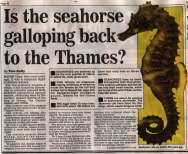 |
In May 2010 short-snouted seahorses were discovered it the waters off Southend. It disappeared due to pollution centuries ago. This indicates the water in the Thames is now clean again. |
|
| |
Boris Island |
|
|
| |
|
Boris Johnson, the London mayor, has described Heathrow as a planning error of the 1960s. Now his officials are drawing up proposals to close it and replace it with a 24-hour airport located on an artificial island in the Thames estuary. If you look at what is going on in other countries around the world - in Hong Kong, in Washington - it's not impossible to move the capital's biggest airport, Johnson has said. It may at first sound implausible, but proposals for an airport in the Thames have endured for almost 40 years. Johnson favours a four-runway hub off Sheppey in Kent, which could easily be expanded to six runways because of minimal planning constraints. The airport would be connected to the high-speed Channel tunnel rail link to transport passengers into central London in about 35 minutes. And the Continent would be just a short train ride away in the opposite direction, cutting out the need for many shorthaul flights. Officials at London's city hall believe the airport could be built in as little as six years and ultimately envisage Heathrow being closed and turned into a high-tech business and residential development.
|
|
| |
Ramsgate Harbour |
|
|
| |
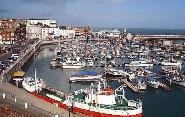 |
The Port of Ramsgate is situated in the South East corner of England with easy access to the North Sea and English Channel.
The port represents a niche UK port facility, capable of handling passenger traffic in an efficient and customer friendly way. The passenger and freight market continues to show an increase in business. The Port of Ramsgate is well placed to offer comfortable and convenient travel to the northern part of mainland Europe and offers itself as the sensible alternative to other channel ports.
Set on 32 acres of dedicated port land, the Port of Ramsgate has three modern Ro-Ro bridges, capable of accommodating conventional Ro-Ro fast ferry freight services. Ramsgate can handle up to 500,000 freight units and five million passengers each year.
Andy did a trial swim from Ramsgate in July 2011 which you can read about in 'Andy's Progress'. |
|
| |
Dover Harbour |
|
|
| |
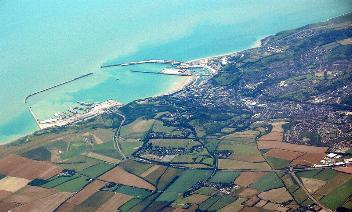 |
Dover is a town and major ferry port in the county of Kent , in South East England . It faces France across the narrowest part of the English Channel. It's strategic position has always been evident throughout its history: Archaeological finds have revealed that the area has always been a focus for people entering and leaving Britain and continues to this day. Services related to the Port of Dover provide a great deal of the town's employment although many of the former ferry services have declined, meaning that unemployment tends to be higher than other parts of Kent. There was a military barracks in Dover, which was closed in 2007.
Andy did a 6 hour qualifying swim in Dover Harbour in July 2011 which you can read about in 'Andy's Progress'. |
|
| |
Shakespeare Beach |
|
|
| |
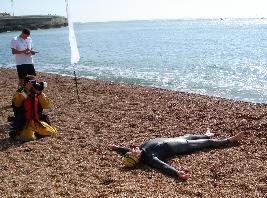 |
Shakespeare Beach is one of the two beaches where cross-Channel swims start. The other is Samphire Beach a couple of miles further from Dover Harbour which you can see in the background of this picture. Andy did a trial swim down at Dover in September 2008 and is pictured here having swum two and half miles in 71 minutes. (He thinks there was a bit of tidal assistance!) He is still debating whether to wear his swimskin for the cross-Channel section as the Cross Channel Swimming Association (CSA) and Channel Swimming and Piloting federation (CS&PF) will not register any cross-Channel swim where the swimmer has worn anything more than a simple swmming costume, a swim hat and goggles. As complying with their registration rules is not important to Andy's swim, he may keep his swimskin on but will take that decision when he gets to Dover. |
|
| |
Cap Gris Nez, Nr. Calais |
|
|
| |
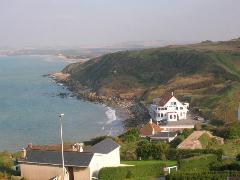 |
Hopefully, when Andy makes it to France the tides will bring him to land at sand rather than the rocks at the point of Cap Gris-Nez.
Many old bunkers from the Second World War can be seen along the coast, walking towards Cap Blanc Nez. Cap Gris-Nez is a real mix and match of concrete bunkers, flak platforms, observation outposts and control bunkers. In fact when you park up at the car park near to the present day Coastguard lookout, you can't help but fall over them. A scenic path takes you on a loop of the cliff top and past many of the emplacements. |
|
|



